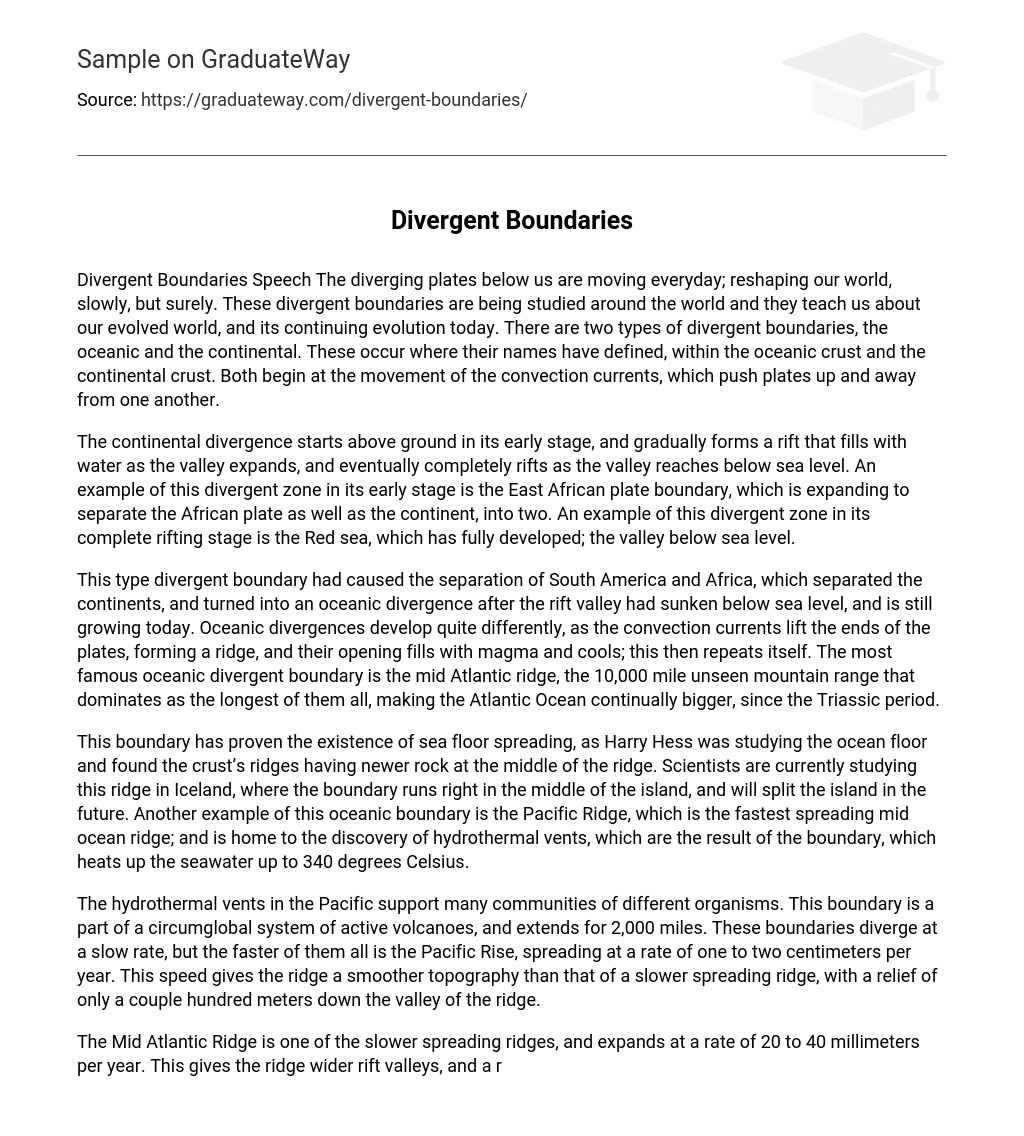The diverging plates below us are moving everyday; reshaping our world, slowly, but surely. These divergent boundaries are being studied around the world and they teach us about our evolved world, and its continuing evolution today. There are two types of divergent boundaries, the oceanic and the continental. These occur where their names have defined, within the oceanic crust and the continental crust. Both begin at the movement of the convection currents, which push plates up and away from one another.
The continental divergence starts above ground in its early stage, and gradually forms a rift that fills with water as the valley expands, and eventually completely rifts as the valley reaches below sea level. An example of this divergent zone in its early stage is the East African plate boundary, which is expanding to separate the African plate as well as the continent, into two. An example of this divergent zone in its complete rifting stage is the Red sea, which has fully developed; the valley below sea level.
This type divergent boundary had caused the separation of South America and Africa, which separated the continents, and turned into an oceanic divergence after the rift valley had sunken below sea level, and is still growing today. Oceanic divergences develop quite differently, as the convection currents lift the ends of the plates, forming a ridge, and their opening fills with magma and cools; this then repeats itself. The most famous oceanic divergent boundary is the mid Atlantic ridge, the 10,000 mile unseen mountain range that dominates as the longest of them all, making the Atlantic Ocean continually bigger, since the Triassic period.
This boundary has proven the existence of sea floor spreading, as Harry Hess was studying the ocean floor and found the crust’s ridges having newer rock at the middle of the ridge. Scientists are currently studying this ridge in Iceland, where the boundary runs right in the middle of the island, and will split the island in the future. Another example of this oceanic boundary is the Pacific Ridge, which is the fastest spreading mid ocean ridge; and is home to the discovery of hydrothermal vents, which are the result of the boundary, which heats up the seawater up to 340 degrees Celsius.
The hydrothermal vents in the Pacific support many communities of different organisms. This boundary is a part of a circumglobal system of active volcanoes, and extends for 2,000 miles. These boundaries diverge at a slow rate, but the faster of them all is the Pacific Rise, spreading at a rate of one to two centimeters per year. This speed gives the ridge a smoother topography than that of a slower spreading ridge, with a relief of only a couple hundred meters down the valley of the ridge.
The Mid Atlantic Ridge is one of the slower spreading ridges, and expands at a rate of 20 to 40 millimeters per year. This gives the ridge wider rift valleys, and a rougher terrain, that can have relief of up to a thousand meters in elevation. Divergent boundaries are a big part of our evolving world today and understanding their ways can benefit our living methods in this galvanizing world. Once we see the congenial aspects of understanding plate tectonics, understanding landforms and continental composition is made simpler. The world is ever changing, and so must the growing knowledge of mankind.
Bibliography
- “Divergent Plate Boundaries. ” Geology. com: News and Information for Geology & Earth Science. N. p. , n. d. Web. 12 Sept. 2012.
- “The East Pacific Rise. ” East Pacific Rise. N. p. , n. d. Web. 12 Sept. 2012.
- “Juan De Fuca Ridge. ” Juan De Fuca Ridge. N. p. , n. d. Web. 12 Sept. 2012.
- “LUMCON’s Estuarine Environment. ” Www. umcon. edu. N. p. , n. d. Web. 10 Sept. 2012.
- “Plate Tectonics : Plate Boundaries. ” Plate Tectonics : Plate Boundaries. N. p. , n. d. Web. 12 Sept. 2012.





